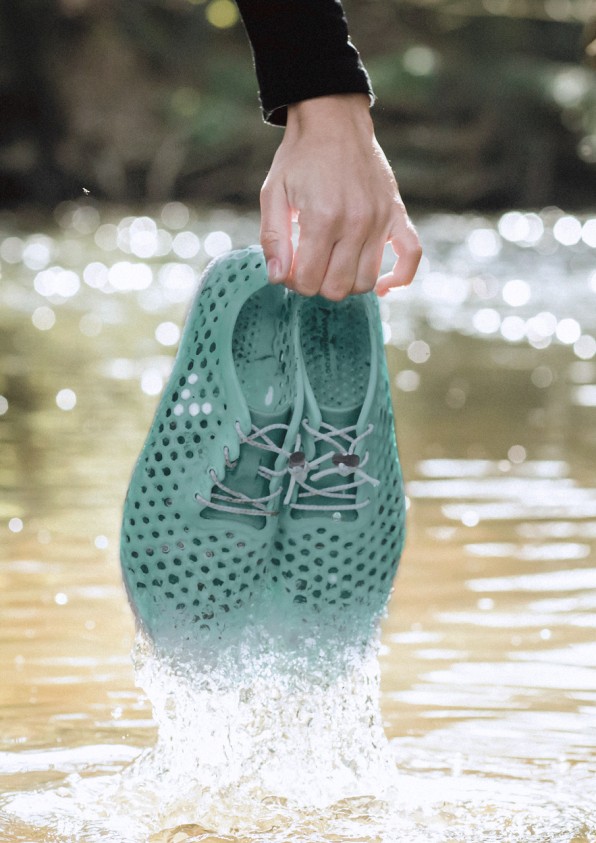These Shoes Help Clean Lakes’ Because They’re Made Of Polluting Algae
By Adele Peters , May 30, 2017
After a massive explosion of algae growth in China’s Lake Taihu a decade ago left more than two million people in the area temporarily without safe drinking water, the government started spending hundreds of millions of dollars a year to try to solve the algae problem. One part of the solution: working with a company that harvests algae from the lake before it grows out of control, and turns it into a flexible, rubbery material that is now being made into shoes.
Vivobarefoot’s water-resistant Ultra III shoes are usually made from a petroleum-based version of the same material, ethylene-vinyl acetate (EVA). But a version that will launch in July is made from a blend of algae and EVA, instead. To get enough algae to make one pair means cleaning 57 gallons of water, which are then returned to the lake.

A company called Bloom supplies the material to Vivobarefoot, producing it using mobile platforms that gently suck algae from the water, returning water that is filtered and clean. The harvested algae is mixed with the raw petroleum material that is typically used to make EVA, helping reduce the carbon footprint of the shoes and cleaning the water of the lake. The current material uses 40% algae and 60% EVA, though Bloom is working on materials that use more algae.
The algae explosions (called blooms, hence the company name) that make this possible are caused by pollution–particularly fertilizer runoff from agriculture–in the water, that can make algae grow uncontrollably, which can cut off oxygen and sunlight for marine animals. Some species of algae also release toxins as they die, that cause even more damage to the ecosystem. While some governments try to reshape the systems that pollute the water (China, for example, closed several factories near Lake Taihu), Bloom is attempting to treat the problem more quickly.
It’s a process that is needed in lakes and other waterways around the world as algae blooms increase. Florida declared a state of emergency in 2016 when algae spread from Lake Okeechobee to nearby beaches, deterring tourists and killing manatees and other wildlife. In Ohio, an algae bloom in the Ohio River made drinking water temporarily unsafe for half a million people in Toledo in 2014. (Bloom’s process can also clean up toxic algae blooms, but the company only makes its material out of out algae that is harvested before it reaches the harmful bloom state.) Climate change is making the problem more common for several reasons, including the fact that algae grow quickly in warmer water.
The first product made from the material was a foam traction pad for a surfboard; the shoes will be the second product to come to market. “For the Ultra, we had spent over a year working with a different company on a closed loop solution but it didn’t work,” says Vivobarefoot founder Galahad Clark. “We knew the EVA foam in the shoe was fundamentally petrochemical based and had no real sustainable [alternative], so we were on the lookout.”
The manufacturing process had a few challenges–the design of the shoe, covered with hexagonal holes to let the foot breathe, requires a detailed, precise mold, and the material had to be tweaked to ensure that it expanded and shrank at exactly the right rate, consistently. But it eventually worked, and the company says that it’s an improvement on the conventional alternative.
“It feels and looks a little better than EVA,” says Vivobarefoot’s creative director Asher Clark, “and it smells like spirulina.”
The new water-resistant Ultra II’s have a little less oil, because some of it’s been replaced by the massive clouds of algae that have been poisoning a Chinese lake.
After a massive explosion of algae growth in China’s Lake Taihu a decade ago left more than two million people in the area temporarily without safe drinking water, the government started spending hundreds of millions of dollars a year to try to solve the algae problem. One part of the solution: working with a company that harvests algae from the lake before it grows out of control, and turns it into a flexible, rubbery material that is now being made into shoes.
Fast Company , Read Full Story
(59)














